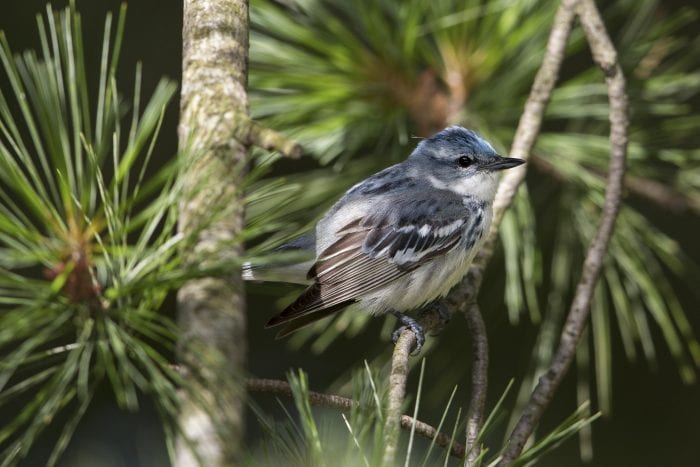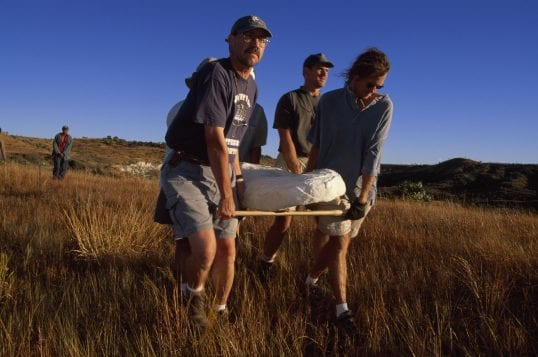PANDEMIC SKY
Dawn Olenick snapped this beautiful sunset pic at the beach in her hometown of Baiting Hollow at the end of April.
Send your Photo of the Week to [email protected]
PANDEMIC SKY
Dawn Olenick snapped this beautiful sunset pic at the beach in her hometown of Baiting Hollow at the end of April.
Send your Photo of the Week to [email protected]

By John L. Turner
For many years there has been a broad public perception that the primary effect of dumping excessive amounts of carbon dioxide (CO2) into the atmosphere, from the burning of fossil fuels (and the release of other gases such as methane from landfills, gas and oil wells, and other sources), was the warming of the atmosphere — a phenomenon that was first called “global warming” or the “greenhouse effect.”
Higher average daily and annual temperatures in the atmosphere have, indeed, occurred, so that label is partially correct — 2019 was the second hottest year ever measured, only slightly behind 2016, and according to records of the National Oceanic and Atmospheric Administration, the past five years are the warmest years on record in the 140-year span the federal government has been measuring atmospheric temperatures; today’s earth is more than two degrees (Fahrenheit) warmer than it was in 1950.
But while the term “global warming” has become shorthand to describe the effect increasing concentrations of atmospheric CO2 have on climate, a wide number of scientists recognize that warming temperatures are but one of many adverse environmental effects caused by too much atmospheric CO2 and, in fact, in some places excess CO2 has caused cooling.
Thus, the term “global warming” both is inaccurate and too restrictive to capture the full range of ecological/environmental impacts and resultantly has fallen into disfavor, replaced by the more accurate label of “climate change” or “climate disruption”. But even these more accurate, expansive labels don’t completely portray the full suite of environmental effects occurring around the world, effects that go far beyond climate, as concerning as that alone would make the climate crisis.
Below is a description of but a few of the many commonly recognized “faces” of climate change that have emerged over the past decade:
More extreme and destructive weather — A warmer atmosphere has more energy and holds more water vapor. This has resulted, in the past decade, of more intense weather events such as increased rainfall and associated flooding, hurricanes, and in some places just the opposite: droughts, often resulting in catastrophic wildfires. Poor Texas: in 2011 the state experienced day time temperatures of over 100 degrees for more than 100 straight days! and experienced a “500-year” storm (a storm of such intensity it is expected to occur once every 500 years) for three straight years (2015-2017).
Sea level rise — As temperatures rise so does the level of the ocean due to thermal expansion and the large volumes of meltwater running off of glaciers and ice caps; it is 2.6 inches higher than 1993 and is rising about one-eighth of an inch per year, a rate that some fear will increase and perhaps increase quickly.
The NYS Department of Environmental Conservation has published sea level rise projections for Long Island; for the 2050s the low projection is an eight inch rise, the medium range projection is 16 inches and the high projection is 30 inches. If the medium to high projections occur, Long Island’s shoreline will be redrawn with marshes and beaches disappearing and thousands of homeowners having to relocate. Miami and many other coastal cities are already being inundated.
Ocean Warming & Acidification — The world’s oceans are warming too and also absorbing the significant majority of excess CO2. When CO2 combines with seawater a weak acid — carbonic acid — is formed. This is not good for shell making creatures like clams and corals. Due to ocean warming and the shifting of pH, coral and other shell making creatures are increasingly stressed. A 2008 study on the health of the planet’s coral reefs indicated that one-fifth are gone with another 15-20% under significant stress.
Impacts to Wildlife — Every other species on Spaceship Earth will potentially be affected by climate change; many have already. Birds, for example, run the risk of starving due to a timing mismatch between when they migrate and when their insect food emerges. A report from the National Audubon Society published in late 2019 finds that two-thirds of North American species are at heightened risk of extinction due to climate change.
Spreading of disease — A number of disease-causing pathogens are likely to get worse as the climate becomes warmer and wetter. Malaria is but one example and it is not a small example. According to the World Health Organization 405,000 people died from contracting malaria last year with 228 million contracting the disease. Closer to home, scientists think both West Nile Virus and Lyme disease will become more prevalent as the planet warms.
A popular slogan seen at climate change rallies is “There is no Planet B.” We can continue to sleepwalk through the issue by electing leaders who “deny” climate change, and pretend there’s a Planet B awaiting us once we finish befouling Planet A. Collectively, we have a fundamental choice to make — we can recognize the madness of this idea, or recognize there is, of course, only one hospitable planet — Planet A — and as occupants of it, we are in a great position to do something about it.
The “faces” of climate change are profound and the magnitude of what needs to be done may seem intractable and overwhelming, leading us to throw up our collective hands in despair.
A much better response is to use those same hands to reduce our carbon footprints by: holding a pen to check the box on the election ballot for candidates who recognize the serious threat climate change poses to nature and humanity, use another pen to write a check to a solar company if you can afford to install roof-top solar panels, twist some new LED light-bulbs into ceiling and lamp sockets, grab a screwdriver and install a dryer vent deflector to have the moist and warm heat from your dryer warm your house in the winter rather than be vented (and wasted) outdoors, lift the lid of your compost bin to compost organic waste, and drop recyclable materials, especially aluminum cans, into your recycling can.
And by completing these actions, and others, you’re acknowledging there is no Planet B, and further, that Planet A, this one small and fragile blue marble floating in a vacuum void, is all we have and all we will ever have. Taking these concrete steps to address the many faces of climate change is bound to put a smile on your face.
A resident of Setauket, John Turner is conservation chair of the Four Harbors Audubon Society, author of “Exploring the Other Island: A Seasonal Nature Guide to Long Island” and president of Alula Birding & Natural History Tours.
By Jeffrey Sanzel

It could not be more appropriate that the new documentary Jane Goodall: The Hope premiered globally on Earth Day, April 22, in 172 countries and 43 languages on National Geographic, Nat Geo WILD and Nat Geo MUNDO channels. At the heart of Goodall’s work is more than just the wonder of nature but the need to respect and honor our coexistence with other species of the planet. Her passionate yet gentle character is iconically associated with this message.
The two-hour film continues where Jane (2017) left off. Jane Goodall: The Hope is an exploration of the work she has done since 1986, when she transitioned from scientist to scientist-advocate. It is a beautiful film, powerful and simple, with no narration. Instead, it is told through interviews juxtaposed with recent and archival footage spanning over six decades.
There are a few nods to her earlier life. One of the first scenes, Goodall shows her childhood copy of The Story of Doctor Dolittle, the book that first opened her eyes to a world of possibilities. There are occasional glimpses into her person life — some time spent with her grandchildren or having a glass of whiskey with friends. But the heart of the film is Jane Goodall as conservationist and messenger.

At 86, Goodall still maintains a grueling schedule of three hundred days on the road, traveling and speaking across the entire globe. In one sequence, she is shown shuttling from airport to hotel room (where she makes toast on an iron) to traveling again.
It would be a difficult schedule for someone a third her age, but Goodall sees it as both quest and responsibility. When told she should slow down, her response is that she must speed up as time is running out. Between tours she lives in the English home that her family has had since 1940, sharing with her younger sister, Judy. We are treated to just a few rare moments of rest, accentuating her constant and unflagging work.
Goodall never sought fame but has reluctantly accepted it to further her cause. She readily admits that she would have preferred to stay in the forests of Gombe, living with and studying chimpanzees, but realized she was in a position to speak out where people would listen.
Whether addressing a crowd of several thousand or interacting with a handful of elementary students, her unique spirit comes through. Her goal is to always reach people through their hearts. She is a guide and a messenger, not a preacher. One boy describes her as “Mother Theresa for the environment.”
Her outreach has included the Jane Goodall Institute as well as the Zanzibar-based Roots and Shoots program. The latter engages young people on issues of conservation and gets them directly involved. She is particularly inspiring to young girls, several of whom give impassioned paeans to Goodall as a role model. In fact, the latter third of the documentary concentrates on her legacy and the myriad results of the seeds she has planted.

The film highlights her ability to connect with people and not divide them. James Baker, former White House Chief of Staff, was an avid hunter. Yet, she was able to find common ground in a belief in clean water. He readily gave her introductions to countries across the world. She developed a long-time relationship with Rodney Macalister, manager for Conoco. Throughout, he is interviewed and marvels at how she managed to get a huge oil company to build a chimpanzee sanctuary. He states simply, “She commands respect in the softest of ways.”
Goodall went into labs that used primates for experimentation so that she could report firsthand. Often questioned by more radical activists, she makes clear that she would rather work with people “to do it better” then to be constantly adversarial. Ultimately, with years of considerable yet considerate pressure, she got the National Institute of Health to reduce its use of animals for the testing of drugs and other experiments. She has the ability to bridge the gap between the most unlikely individuals.
It should be noted that there is disturbing footage of the torture and mistreatment of chimpanzees. The filmmakers have wisely not overused these important images but they are as devastating as they are essential in their depiction of cruelty and neglect.
The documentary clearly shows Goodall’s inner focus: “I believe only that when head and heart can work in harmony we can achieve our true potential.” Her message is shared with everyone from the youngest children to the most educated of academics, from politicians to Prince Harry. And her affect on them is clear.
She is hope attached to action. She understands that to make conservation work you have to engage with the local people and make their lives better. Conservation must help through community, remembering that there are basic needs that will come first (e.g., health, water, education).
Ultimately, it is Jane Goodall’s optimism that shines through. Her belief that the young people can and will make the world a better place. One of the final moments of the film is her speaking to a sold-out crowd. She raises her hand and says: “Together we can —together we will save the world.” And because she believes, it makes us believe it too. Jane Goodall: The Hope is an important film in the truest of ways. It is not just to be seen; it is to be shared.
Jane Goodall: The Hope is now streaming free on demand.







By Daniel Dunaief
It’s not exactly a Rembrandt hidden in the basement until someone discovers it in a garage sale, but it’s pretty close.
More than two decades ago, a Malagasy graduate student named Augustin Rabarison spotted crocodile bones in northwestern Madagascar, so he and a colleague encased them in a plaster jacket for further study.
David Krause, who was then a Professor at Stony Brook University and is now the Senior Curator of Vertebrate Paleontology at the Denver Museum of Nature & Science, didn’t think the crocodile was particularly significant, so he didn’t open the jacket until three years later, in 2002.
When he unwrapped it, however, he immediately recognized a mammalian elbow joint further down in the encased block of rock. That elbow bone, as it turned out, was connected to a new species that is a singular evolutionary masterpiece that has taken close to 18 years to explore.
Recently, Krause, James Rossie (an Associate Professor in the Department of Anthropology at Stony Brook University) and 11 other scientists published the results of their extensive analysis in the journal Nature.
The creature, which they have named Adalatherium hui, has numerous distinctive features, including an inexplicable and unique hole on the top of its snout, and an unusually large body for a mammal of its era. The fossil is the most complete for any Mesozoic mammal discovered in the southern hemisphere.
“The fossil record from the northern continents, called Laurasia, is about an order of magnitude better than that from Gondwana,” which is an ancient supercontinent in the south that included Africa, South America, Australia and Antarctica, Krause explained in an email. “We know precious little about the evolution of early mammals in the southern hemisphere.”
This finding provides a missing piece to the puzzle of mammalian evolution in southern continents during the Mesozoic Era, Krause wrote.
The Adalatherium, whose name means “crazy beast” from a combination of words in Malagasy and Greek, helps to broaden the understanding of early mammals called gondwanatherians, which had been known from isolated teeth and lower jaws and from the cranium of a new genus and species, Vintana sertichi, that Krause also described in 2014.
The closest living relatives of gondwanatherians were a group that is well known from the northern hemisphere, called multituberculates, Krause explained.
The body of Adalatherium resembled a badger, although its trunk was likely longer, suggested Krause, who is a Distinguished Service Professor Emeritus at Stony Brook.
Krause called its teeth “bizarre,” as the molars are constructed differently from any other known mammal, living or extinct. The front teeth were likely used for gnawing, while the back teeth likely sliced up vegetation, which made probably made this unique species a herbivore.
The fossil, which probably died before it became an adult, had powerful hind limbs and a short, stubby tail, which meant it was probably a digger and might have made burrows.
Rossie, who is an expert in studying the inside of the face of fossils with the help of CT scans, explored this unusually large hole in the snout. “We didn’t know what to make of it,” he said. “We can’t find any living mammal that has one.”
Indeed, the interpretation of fossils involves the search for structural and functional analogs that might suggest more about how it functions in a living system. The challenge with this hole, however, is that no living mammal has it.
Gathering together with other cranial fossil experts, Rossie said they agreed that the presence of the hole doesn’t necessarily indicate that there was an opening between the inside of the nose and the outside world. It was likely plugged up by cartilage or other soft tissue or skin.
“If we had to guess conservatively, it would probably be an enlarged hole that allowed the passage of a cluster of nerves and blood vessels,” Rossie said.
That begs the question: why would the animal need that?
Rossie suggests that there might have been a soft tissue structure on the outside of the nose but, at this point, it’s impossible to say the nature of that structure.
The Associate Professor, who has been a part of the research team exploring this particular fossil since 2012, described the excitement as being akin to opening up a Christmas present.
“You’re excited to see what’s in there,” he said. “Sometimes, you open up the box and see what you were hoping for. Other times, you open the box and say, ‘Oh, I don’t know what to say about this [or] I don’t know what I’m looking at.’”
For Rossie, one of the biggest surprises from exploring this fossil was seeing the position of the maxillary sinus, which is in a space that is similar across all mammals except this one. When he first saw the maxillary sinus, he believed he was looking at a certain part of the nasal cavity, where it usually resides. When he studied it more carefully, he realized it was in a different place.
“All cars have some things in common,” said Rossie, who is interested in old cars and likes to fix them. The common structural elements of cars include front and back seats, a steering wheel, and dashboard. With the maxillary sinus “what we found is that the steering wheel was in the back seat instead of the front.”
A native of upstate Canton, which is on the border with Canada, Rossie enjoyed camping growing up, which was one of the initial appeals of paleontology. Another was that he saw an overlap between the structures nature had included in anatomy with the ones people put together in cars.
A resident of Centerport, Rossie lives with his wife Helen Cullyer, who is the Executive Director of the Society for Classical Studies, and their seven-year-old son.
As for the Adalatherium, it would have had to avoid a wide range of predators, Krause explained, which would have included two meat-eating theropod dinosaurs, two or three large crocodiles and a 20-foot-long constrictor snake.
By Daniel Dunaief
Long Islanders are pitching in to protect the people of Madagascar, called the Malagasy, from COVID-19. They are also trying to ensure the survival of the endangered lemurs that have become an important local attraction and a central driver of the economy around Ranomofana National Park.
Patricia Wright, a Distinguished Service Professor at Stony Brook University and founder and executive director of the research station Centre ValBio (CVB), is working with BeLocal to coordinate the creation and distribution of masks. They have also donated soap, created hand washing stations at the local market, and encouraged social distancing.
BeLocal, an organization founded by Laurel Hollow residents Mickie and Jeff Nagel, along with Jeff’s Carnegie Mellon roommate Eric Bergerson, is working with CVB to fund and support the creation of 200 to 250 masks per day. BeLocal also purchased over 1,800 bars of soap that they are distributing at hand washing stations.

All administrators for regional government in the national park area near CVB, which is in the southeastern part of the island nation, have received masks. The groups have also given them to restaurant owners and anybody that handles food, including vendors in the market.
At the same time, CVB has received permission to become a testing site for people who might have contracted COVID-19. At this point, Wright is still hoping to raise enough money to buy a polymerase chain reaction machine, which would enable CVB to perform as many as 96 tests each day.
The non-governmental organization PIVOT, which was founded by Jim and Robin Hernstein, has also helped create screening stations to test residents for fever and other symptoms of the virus. As for the masks, BeLocal and CVB are supporting the efforts of seamstresses, who are working 7 days a week.
Jessie Jordan, a wildlife artist based in Madagascar who has been living at CVB for several weeks amid limited opportunities to return to the United States, has been “busy collaborating with local authorities and contributing masks, soap and hand washing stations to the community.”
At this point, Jordan said people were concerned about the economy, but not as afraid of the virus. “The local health centers are less busy right now because of confinement measures and people are scared of testing positive,” she explained in an email.
The Malagasy who benefit from the national park economically through tours and the sale of local artwork have suffered financially. Social distancing in the cities is “nearly impossible,” while Jordan said she has heard that some people in the countryside don’t have access to TV or radio and are not aware of the situation.
As of last week, Madagascar had 132 confirmed positive cases of the virus. Through contact tracing, the government determined that three people brought COVID-19 to the nation when they arrived on different planes. The country had 10 ventilators earlier this month for a population that is well over 23 million.
BeLocal researched the best material to create masks that would protect people who worked in the villages around Ranomafana. “We researched templates and materials and worked together with CVB to choose the best material that would be available,” Leila Esmailzada, the Executive Director of BeLocal, explained in an email.
BeLocal organized a team that reached out to Chris Coulter, who had started making soap several years ago. Coulter has worked with local officials to make soap.
“We knew Coulter from a few years ago” from an effort called the Madagascar Soap Initiative to get soap into every home and make it accessible, explained Mickie Nagel, the Executive Director of BeLocal. “We hope the people making it right now will consider turning this into a business.” Before Madagascar instituted restrictions on travel, BeLocal and CVB had purchased several sewing machines.
Representatives from BeLocal and CVB have been conducting hand washing and social distance education efforts to encourage practices that will limit the spread of COVID-19. Government officials have also shared instructions on the radio and TV, Wright said. When the mayor of Ranomofana Victor Ramiandrisoa has meetings, everybody stands at least six feet apart.
CVB has produced picture drawings in Malagasy that are plastered on the sides of cars that describe hand washing procedures and social distancing. “We also have educational signs in the post offices, restaurants and in the mayor’s offices that we paid for,” Wright explained. She said the government, CVB and BeLocal are all educating people about practices that can limit the spread of the deadly virus.
“Organizations in Ranofamana are collaborating with the local government on efforts to prevent the spread of COVID-19,” Esmailzada wrote. “The local government recently began conducting PSA’s along the road and in main markets about hand washing, mask wearing and social distancing and CVB staff are leading by example.”
As for the lemurs Wright, whose work was the subject of the Imax film “Island of Lemurs: Madagascar,” said the country has taken critical steps to protect these primates.
“The government of Madagascar is assuming the worst and is not allowing anybody into the park,” Wright said. The president of Madagascar, Andry Rajoelina, has closed national parks to protect the lemurs, Wright said.
The lemurs have the support of conservation leader Jonah Ratsimbazafy, who earned his PhD while working with Wright at Stony Brook University. Ratsimbazafy is one of the founding members of the Groupe d’Etude et de Research sur les Primates, which is a community based conservation organization that protects lemurs.
Wright and others are concerned the virus may spread to lemurs. Several lemurs species have the angiotensin converting enzyme, or ACE2, that forms the primary point of attachment for the virus in humans.
Indeed, scientists around the world are working to find those species which might be vulnerable to the virus. According to recent research preprinted in bioRxiv from a multi-national effort led by scientists at the University of California in Davis, several species of lemur have high overlap in their ACE2 inhibitors. This includes the endangered aye-aye lemur, which is the world’s largest nocturnal primate, and the critically endangered indri and sifaka.
“We are worried that lemurs might get the virus,” Wright said.
Photos courtesy of Jessie Jordan
By John L. Turner
This is the second of a two-part series.
In part one of “Curious Books Upon My Bookshelf” (March 26 issue of Arts & Lifestyles) I focused on items I’ve collected through the years on walks along Long Island’s shoreline. In this part we go “inland” to discuss a few of Mother Nature’s gifts I’ve found while exploring Long Island’s fields and forests.
I like to stray off paths to “bushwhack” through a forest (a habit that has led me to meet more ticks than I’ve ever desired!), walking quietly, slowly and carefully in search of wildflowers, bird nests, snakes, box turtles and other objects of interest. It’s a bit like the method people use when walking around an old store filled with interesting antiques and nicknacks. If you do this (in the forest and not the store) it’s just a matter of time before you find one or more of these objects.
On numerous occasions I’ve come across the remains of a white-tailed deer — ribs, a pelvic girdle, vertebrae, sometimes skulls, but most often their shed antlers, laying amidst the leaves, slowly melting back into the earth. Their final resting spots are a solemn place and I invariably wonder what caused their death. Predator? (not yet at least, not until coyotes become more fully established on Long Island) Starvation? An accident? Succumbing to wounds from a hunting slug?I almost always don’t know.
Deer antlers are a thing of beauty; while they are generally variations on a central theme of a main shaft with arms or “points” emanating from it, each antler is unique. Grown and shed each year (unlike horns on a bison or bighorn sheep which are not shed but grow continuously throughout an animal’s lifetime), antlers generally get larger as the animal matures so an eight year buck will have a larger set of antlers than a three-year-old.
On occasion I’ll find an antler that has been extensively gnawed upon — this is not surprising. Antlers are composed of bone and contain calcium and minerals and a number of animals will take advantage of this prized “dietary supplement.” A four-state study to learn which animals eat antlers determined that grey squirrels most often gnawed on them; eleven species were tallied in all including, not surprisingly, other gnawing animals — chipmunks, rabbits, mice and woodchucks. A little more surprising were raccoons, coyotes, opossum, river otter and one beaver.
I occasionally encounter other mammal skulls besides deer. I have a few raccoon skulls, a woodchuck skull, a red fox skull, and my prized skull — that of a grey fox. This secretive and beautiful mammal is less well known than the more common red fox (the first grey fox I ever saw had climbed a persimmon tree in Maryland and was chowing down on tree ripe persimmons).
On Long Island I’ve been fortunate to have seen  live grey fox, the most recent experience in the autumn two years ago. Spying him before he saw me as I fortuitously was hidden behind a bushy, young Pitch Pine tree, this beautiful grizzled looking animal was patrolling along a sandy trail in the Dwarf Pine Plains of the Long Island Pine Barrens.
live grey fox, the most recent experience in the autumn two years ago. Spying him before he saw me as I fortuitously was hidden behind a bushy, young Pitch Pine tree, this beautiful grizzled looking animal was patrolling along a sandy trail in the Dwarf Pine Plains of the Long Island Pine Barrens.
Speaking of pines, pine cones are one of my favorite objects to collect; they adorn my shelves. Their varied but unifying symmetry is always a visual delight. I have many Pitch Pine cones, a few from White Pine, a Lodgepole Pine, a Norway Spruce, and even a Stone Pine from the west coast of Italy.
The smallest, most inconspicuous cone I have is my favorite though. It is a cone from a Pitch Pine but it doesn’t look like the other Pitch Pine cones I have; this one is a “closed” or “serotinous” pine cone from a dwarf pitch pine growing in the Dwarf Pine Plains on Long Island.
On tree-sized pitch pines the cones look like normal cones — as they mature the scales open up and the winged seeds flutter to the ground. But the pine cones that grow on the dwarf pine trees don’t typically open upon maturing. Rather, they remain resolutely closed, sometimes for decades — unless and until burned in a wildfire.
That this closed cone trait evolved with the dwarf pines makes sense because in a wildfire all of the dwarf stature trees are likely to burn, unlike in a forest of fifty-foot tall pines. If the pygmy pines had “normal” cones it is very likely all of the seeds would perish in a wildfire. The closed cones, however, protect the sensitive pine seeds inside the cone. It is a finely tuned system — the resins that hold the scales together in a serotinous cone melt in fire, allowing the scales to spread open over the course of hours, thereby releasing the seeds onto a forest floor with lots of available ash, nutrients, and sunlight — great conditions to start a new generation of dwarf pines in this fire-dependent forest.
The Dwarf Pine Plains, a globally rare part of the Long Island Pine Barrens, are situated in Westhampton. A circular interpretive hiking trail leads into the forest from the southern end of the parking lot of the Suffolk County Water Authority building located on the east side of County Route 31 about 200 yards south of the Sunrise Highway x County Route 31 intersection. That is where I saw the grey fox. If you go maybe you too will be lucky enough to see a fox sniffing in the sand in search of food!
A resident of Setauket, John Turner is conservation chair of the Four Harbors Audubon Society, author of “Exploring the Other Island: A Seasonal Nature Guide to Long Island” and president of Alula Birding & Natural History Tours.
By Daniel Dunaief
Small primates on an island nation off the southeastern coast of the African continent need about a million dollars.
That’s how much it might take to keep Ranofamana National Park, where Centre ValBio is located, afloat financially until people develop a vaccine.
Patricia Wright, who founded CVB, has spent the last 36 years studying a wide range of lemurs, even as she has integrated her efforts into the life of the Malagasy.
While she won conservation awards in the United States, including the 2014 Indianapolis Prize for Conservation from the Indianapolis Zoo, Wright has also won three medals of honor from the government of Madagascar as she has taken steps to improve the economic and physical health of the people who live around Ranomofana.
Now, with tourists who might be carriers of COVID-19 excluded from the national parks, lemur conservation, the tour guides who provide colorful commentary about the world-renowned primates, and the artists who provide local flavor and collectibles for visitors are all under duress.
The tour guides are “local residents and are incredible,” Wright said. “They are locally trained.” Indeed, many of those who share the natural riches of the region used to be loggers when they were younger.
“We’re talking about people and about critically endangered lemurs,” she added.
Wright often highlights the positive feedback loop between conservation and the local economy, which has created job opportunities even as it has enabled the country to attract tourists from around the world who celebrate the land of the lemur.
Building on her experience with delivering medicine to people around the national park, Wright plans to bring a polymerase chain reaction machine to Centre ValBio to test people for COVID-19.
Wright is seeking financial support from those who would like to ensure that the sifaka lemur, named after the “shi-fa” alarm call it makes when it feels threatened; the aye-aye lemur, which is the largest nocturnal primate in the world; and the indri lemur outlast the devastating effects of a virus that threatens the lives of people throughout the world.
Someday, when the smoke has cleared and people can look at what’s left in the world, Wright hopes Ranomafana Park and its lemurs are not only one of the survivors, but are also a rare, ecological site that calls to visitors from all over the world eager to celebrate the cultural richness of the Malagasy as well as the lemurs and other rare creates calling to each other from the rainforest.
Those interested in donating to this effort may visit the CVB web site at Welcome to Centre ValBio at Stony Brook University.

By Melissa Arnold
There’s nothing quite like spring in full bloom — the weather’s finally breaking, flowers are popping up everywhere, and it’s easy to get the kids outside for some fresh air and sunshine, even in the middle of a pandemic.
Unfortunately, most of the area’s most beloved spring locales are closed, their events canceled indefinitely until cases of COVID-19 have declined to safer levels. Without their usual income, many small businesses are struggling to pay the bills and must find creative new ways to keep the lights on.
Among them are Benner’s Farm in Setauket, well known in the community for its seasonal festivals and educational opportunities for both children and adults. With in-person field trips and large gatherings impossible, they’re trying to reinvent the wheel.
“Normally this time of year would have class after class coming in to see the farm and our new animals,” said owner Bob Benner. “We’ve had births of lambs, goat kids, chicks and bunnies, but no one can visit them — there are no workshops or Mommy and Me events, no birthday parties …. there’s literally nothing. So we’ve had to ask ourselves, ‘What can we do?’”
At Easter time, with 20,000 candy-filled eggs ready to go, Bob awoke in the middle of the night with an idea: What if they sold 50-egg boxes for families to have their own hunts at home? By the time the holiday arrived, they’d sold 100 boxes. Encouraged, the Benners sought to continue the momentum.
Next came an online store, with t-shirts and maple products for sale at www.bennersfarm.com, and a GoFundMe campaign which raised more than $6,000 to keep staff paid and animals fed.
Now they’ve created a “My First Garden Learning Kit” geared toward children containing everything you need to grow a dozen different flowers and plants. The kits include planters, potting soil, a template to sort and examine seeds, plant markers, and an instruction booklet with pictures and information about each plant at various stages of growth.
Both Bob and his wife Jean have spent decades working as teachers in addition to running the farm. Jean said that they work hard to approach every project with an educational focus, trying to see each aspect as a child would.
“We purposely chose seeds that are all different sizes and shapes, mature at different times, and are not too tiny so that kids can handle them,” she explained. “The seeds we’ve chosen are all meant to be interesting and recognizable. Marigold seeds look like tiny paintbrushes; calendula seeds resemble tiny worms.”
The seed starter kits went on sale at the end of April. Within two days, they’d sold 70 kits and were ordering more boxes to fill. So far, so good.
“It’s been successful especially because people are telling their friends and family. We’ve had orders come in from other places around the country, too,” said Jean.
The Benner family moved to Setauket from Northport in the late 1970s. Their eldest son, Ben, said that his earliest memories involved being dressed in overalls and driven to see the badly overgrown property. The area was first farmed in the 1750s, and the Benners revitalized it using books on homesteading as a guide. What was originally meant to be a hobby for Bob and Jean slowly evolved into something much more.
“This is our life here, and it’s so strange to see the farm empty,” Ben said. “We miss the energy of the kids, getting to see people every day, hosting our programs. This is all we want to do.”
While the Benners have no idea what the future holds or what events they’ll be able to host next, they know that the success of the farm rests in continuing local support and encouraging a love for nature in children.
“As a society, we’ve lost a certain amount of knowledge and appreciation for nature. Kids that grew up in previous generations would be out working in farms and gardens, and that doesn’t happen much around here anymore,” Ben said. “I think it’s such an important thing to learn about the process of how plants grow, and it’s a lot of fun to go out and pick your food, knowing where it comes from and knowing you did it yourself. We want to spark that interest in as many kids as possible.
Seeds included in the garden kit:
▪ Calendulas
▪ Sunflowers
▪ Zinnias
▪ Marigolds
▪ Green squash (zucchini)
▪ Purple bush beans
▪ Peas
▪ Corn
▪ Beets
▪ Swiss chard
▪ Radishes
▪ Tomatoes
Each kit costs $25. They can be picked up from Benner’s Farm at 56 Gnarled Hollow Road, Setauket. Call ahead to arrange an in-person, contactless pickup. Prepayments using a credit or debit card are preferred, but arrangements can be made for cash payment. Online orders placed at www.bennersfarm.com are $35 each and will be sent out within 24 hours. For the latest information about the farm, to make purchases or donations, call 631-689-8172 or visit their website.
Reviewed by Jeffrey Sanzel
“I feel very strongly in the sort of planning that I do, that you feel the changes all the time. It is a changing beauty: from beauty into beauty.” — Piet Oudolf
In the introduction of Gardens of the High Line, Richard Hammond, co-founder of Friends of the Highline, addresses the issues that confronted the creators of the gardens. Is the goal to preserve the natural wildness of the vegetation or to recreate entirely? The final decision was to find something in between, that both honors the desire to conserve but also understands the value of change.

What resulted was both native and introduced flora: “[a] multi-season garden of perennials, where the skeletons of plants have as much a part in the landscape as new growth … the wilderness in the city, the art museum on a train track. Like the park itself, the gardens hover between beauty and decay.”
The High Line gardens are a true reflection of New York City. It is a place of growth and loss, romance and introspection; elements that are fixed and others that are constantly transforming. And, amazingly, it is where these aspects can co-exist.
The book’s prose is as elegant and eloquent as its imagery. It gives multi-leveled insight to not only the creation of the space but the more esoteric motivations beneath. It takes the reader through the history of the High Line and its roots in industry. It discusses its changing identity and evolution and, finally, its reinvention.
There is also a detailed exploration of wild gardens, citing historical sources, and how untamed growth often transforms ruins. It explains the art that inspires and the craft that designs — and, most importantly — the alchemy that joins the two. This is not your average gardening book.
 “Though it’s unlikely there will ever be another place quite like the High Line, it offers a wealth of insights and approaches worthy of emulation in gardens large or small, public or private. Authentic in spirit and execution, the High Line’s gardens offer a journey that is intriguing, unpredictable, imperfect, and, above all, transformative.”
“Though it’s unlikely there will ever be another place quite like the High Line, it offers a wealth of insights and approaches worthy of emulation in gardens large or small, public or private. Authentic in spirit and execution, the High Line’s gardens offer a journey that is intriguing, unpredictable, imperfect, and, above all, transformative.”
After the introductory analyses, the book begins at the southernmost end of the High Line, at the Gansevoort Woodland, the area that is Gansevoort Street through Little West 12th Street. The route continues north, each section highlighting a different area: Washington Grasslands, Hudson River Overlook, etc., going all the way up to the Rail Yards, ending at West 34th Street.
Ultimately, the glory of this book is the hundreds of photos by Rick Darke to be seen and savored. The photography is vivid, an explosion of color and texture. The chapters offer dozens of photos that span a range of viewpoints, showing the change of seasons, both extreme and subtle. Each turn of the page reveals the gardens in some different perspective, no two alike, but allowing the viewer to see the similarities as well as the contrasts. The book shows both an unbridled and an organized environment through the prism of the world as nature’s art gallery.

In the end, the authors see the book’s goal as one that will “serve as a beautiful memory of a great place, as guide to the infinite opportunities it presents to practice the art of observation and as an inspiration to all who, publicly or privately, seek to elevate the nature of modern landscapes.” They have succeeded in a work that honors artistry and insight with deep understanding, celebrated through hundreds of dazzling and breathtaking images.
Published by Timber Press, Gardens of the High Line: Elevating the Nature of Modern Landscapes is available online at www.timberpress.com, www.amazon.com and www.barnesandnoble.com.
PICTURE PERFECT
Joe Glenn was lucky enough to spot this beautiful deer while visiting Avalon Park & Preserve in his hometown of Stony Brook. While the park remains open to visitors, the entrance at the Stony Brook Grist Mill is now temporarily closed for renovations.
Send your Photo of the Week to [email protected]
